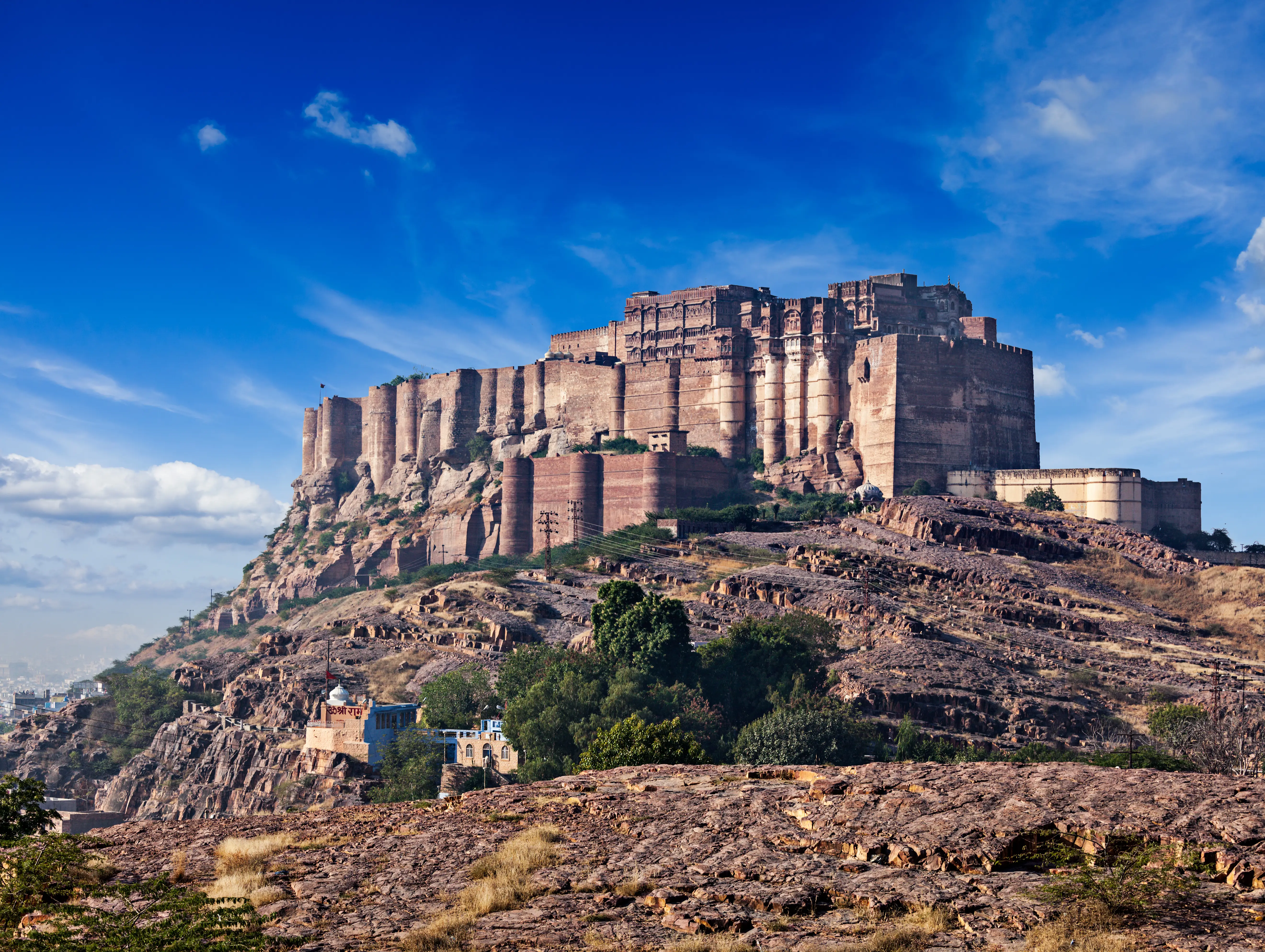Rajasthan Tourism: Royal Forts, Colorful Cities & Desert Adventures
September 20, 2025

Rajasthan Tourism: Royal Forts, Colorful Cities & Desert Adventures
Rajasthan, the “Land of Kings,” is not just a state in India—it is a living epic written across deserts, palaces, forts, and folk traditions that have endured for centuries. Travelers who step into Rajasthan enter a world of royal grandeur, where every city has a distinct color, every fort tells a tale of valor, and every dune whispers the stories of caravans and kings. The magic of Rajasthan tourism lies in its contrasts: majestic forts perched on rugged hills, bustling bazaars filled with color, desert landscapes that stretch endlessly, and lakes shimmering with palaces afloat.
To explore Rajasthan is to discover a land where history is not confined to books but breathes in stone walls, folk songs, and everyday life. From the pink charm of Jaipur to the golden desert city of Jaisalmer, from the blue alleys of Jodhpur to the lakes of Udaipur, the journey through Rajasthan is a kaleidoscope of experiences.
Jaipur: The Pink City of Palaces
Jaipur, the gateway to Rajasthan tourism. welcomes travelers with a blend of heritage and energy. Maharaja Jai Singh II founded the city in 1727, and it remains one of the earliest examples of urban planning in India. Its old city, painted pink in honor of a British royal visit, glows at sunset with an otherworldly charm.
The Amber Fort, perched on a hill, embodies Rajput grandeur. Its mirrored halls sparkle like a starry sky, while elephants once carried kings through its gates. Walking through its courtyards, travelers sense both the weight of history and the artistry of Rajasthan’s finest architects.
The Hawa Mahal, with its honeycomb façade, is Jaipur’s most iconic symbol. Travelers recall standing before its delicate lattice windows, imagining the royal women who once gazed through them unseen. The City Palace offers another dimension—an active royal residence that opens its courtyards and galleries to visitors, blending the past with the present.
Jaipur is also a city of markets. Johari Bazaar dazzles with gemstones, Bapu Bazaar with vibrant textiles, and Tripolia with traditional crafts. The taste of pyaaz kachoris, sweet lassi, and spicy chaats stays with visitors long after they leave.
Jodhpur: The Blue City Beneath the Mighty Fort
Journeying west, the traveler reaches Jodhpur, where the blue-painted houses of the old city stretch like a sea beneath the towering Mehrangarh Fort. Rising 400 feet above the plains, Mehrangarh is one of India’s most formidable forts. Its gates still bear cannon marks, its walls rise with defiance, and its palaces glow with intricate carvings and gilded chambers.
Travelers climbing the fort’s ramparts often pause to gaze at the panorama—the blue city sprawling endlessly, desert winds brushing against ancient stones. Inside, the museum displays royal cradles, palanquins, and weapons that tell the story of Marwar’s valor.
Yet Jodhpur is not only about the fort. The bustling Sardar Market near the clock tower brims with spices, fabrics, and handicrafts. The scent of cumin and turmeric fills the air, while travelers bargain for colorful turbans and embroidered shoes. In the evenings, many recall sitting in rooftop cafes, sipping chai, and watching Mehrangarh glow golden in the setting sun.
Udaipur: The City of Lakes and Romance
If Jaipur is royal and Jodhpur is rugged, Udaipur is romantic. Nestled among the Aravalli hills, Udaipur shimmers with lakes and palaces that seem straight out of fairy tales. Founded in the 16th century by Maharana Udai Singh, it became the capital of Mewar and still retains an air of majesty softened by natural beauty.
Lake Pichola is Udaipur’s crown jewel. The Lake Palace, now a luxury hotel, floats like a dream on its waters, while the City Palace rises proudly along its shores. Travelers often recall the experience of boating at sunset, watching the palace lights reflect on the lake, a sight they describe as magical and unforgettable.
The City Palace itself is a marvel—an enormous complex of courtyards, balconies, and halls adorned with mosaics and glasswork. Stories of Rajput bravery, of battles fought and alliances forged, echo within its walls. For many, Udaipur is where Rajasthan feels most serene—a place to slow down, stroll through narrow streets, and absorb the beauty of both nature and heritage.
Jaisalmer: The Golden City of the Desert
Farther west, the Thar Desert unveils Jaisalmer, a city that glows golden under the desert sun. Its fort, unlike most others, is still alive with homes, temples, and shops inside its walls. Known as Sonar Quila, or the Golden Fort, it rises like a mirage from the sand, its honey-colored sandstone turning fiery at sunset.
Travelers often describe Jaisalmer as stepping into another world. Narrow lanes within the fort reveal ornately carved havelis like Patwon ki Haveli, with sandstone facades so detailed they resemble lace. The Jain temples inside the fort dazzle with intricate marble carvings that rival the finest European cathedrals.
Yet the true adventure of Jaisalmer lies in its desert. Camel safaris take travelers deep into the dunes, where the silence is broken only by the wind and the rhythm of hooves. Nights spent under starlit skies, with folk music and Rajasthani meals by the fire, are remembered as some of the most magical experiences in India.
Pushkar: The Sacred Town with a Festive Spirit
Nestled around a holy lake, Pushkar is a town of temples, ghats, and spiritual energy. The Brahma Temple, dedicated to the creator god, is unique in the world, drawing pilgrims and curious travelers alike. The town pulses with a blend of devotion and bohemian charm, attracting both sadhus and backpackers.
Every November, Pushkar transforms into a carnival during the Pushkar Camel Fair. Thousands of camels, horses, and cattle fill the desert grounds, while traders, musicians, and dancers create a spectacle like no other. Travelers who have attended often recall the riot of colors, competitions, and cultural shows as a surreal mix of tradition and festivity.
Bikaner: The Desert’s Hidden Gem
Though less visited than Jaipur or Udaipur, Bikaner is a treasure for those who seek Rajasthan’s deeper layers. Junagarh Fort, unlike most forts in Rajasthan, is built on the plains and boasts exquisite palaces with frescoes, marble floors, and gilded balconies.
Bikaner is also famous for its camel breeding farm and the Karni Mata Temple, known to many as the “Rat Temple,” where thousands of rats are revered as sacred. For adventurous travelers, it is an unforgettable experience, part sacred ritual, part cultural wonder.
And of course, no mention of Bikaner is complete without its food. Bikaneri bhujia, spicy snacks, and sweets like rasgullas make the city a favorite among food lovers.
The Colors of Rajasthan
One of the unique aspects of Rajasthan tourism is its colorful cities, each with a distinct hue that defines its character. Jaipur is the Pink City, Jodhpur the Blue City, Udaipur the White City, Jaisalmer the Golden City, and Bikaner the Red City. Together they form a palette that reflects not only architectural choices but also traditions, symbolism, and identity.
Travelers often marvel at this interplay of color—the pastel pink facades glowing at Jaipur’s sunrise, the cobalt blue houses of Jodhpur shining under desert skies, the golden fort of Jaisalmer shimmering like fire, and Udaipur’s white palaces mirrored in the lakes. The colors make Rajasthan feel like an artist’s canvas brought to life.
The Desert Adventures
Beyond its cities and palaces, Rajasthan offers adventures shaped by the Thar Desert. Camel safaris, jeep rides across dunes, and camping under the stars are experiences that reveal the land’s raw beauty. The silence of the desert, broken by folk songs sung by local performers, has left countless travelers spellbound.
For some, desert adventures are about adrenaline—dune bashing, paragliding, or exploring remote villages. For others, it is about solitude—sitting by a fire, gazing at constellations, and feeling the timeless rhythm of desert life.
Stories and Memories
The stories of Rajasthan are not only written in history books but also carried in the memories of travelers. One traveler recalled the sight of Mehrangarh Fort lit at night: “It felt like a fortress in the sky, a kingdom alive with echoes of the past.” Another wrote of the camel safari in Jaisalmer: “As the sun dipped into the dunes, I felt as though time itself had paused.”
Many remember Udaipur for its romance: the shimmering lakes, boat rides under the moonlight, and palace walls that seemed to whisper secrets of love and loyalty. Others recall Jaipur’s chaos, bargaining in its bazaars, or savoring sweets at roadside stalls.
For countless visitors, Rajasthan becomes more than a destination—it is a feeling, an immersion in a world where the past is still part of the present, where every moment carries the weight of history and the joy of discovery.
